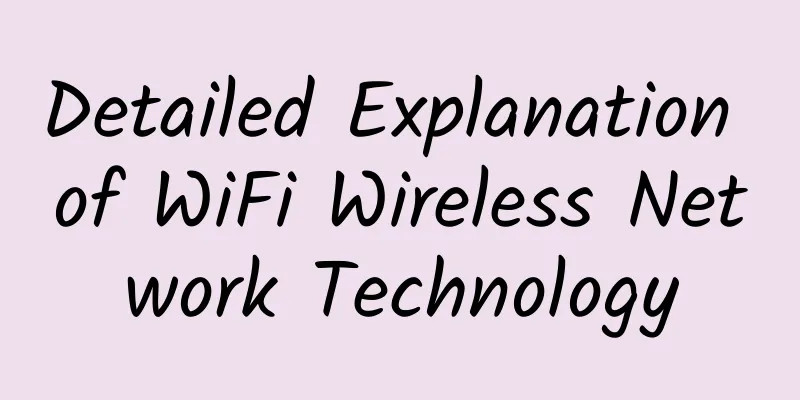Detailed Explanation of WiFi Wireless Network Technology

|
Introduction to Wireless Networks Wi-Fi is a technology that allows electronic devices to connect to a wireless local area network (WLAN), usually using the 2.4G UHF or 5G SHF ISM radio frequency bands. Connections to wireless LANs are usually password protected; but they can also be open, allowing any device within range of the WLAN to connect. Now the main frequencies of WIFI networks are 2.4GHz and 5GHz, and the speeds are divided into ABGN AC;
2.4G and 5G Frequency 2.4GHz and 5GHz 2.4G The advantage is that the frequency band has strong anti-attenuation ability in indoor environment and good wall penetration ability. The disadvantage is that many devices use 2.4GHz, such as Bluetooth and Zigbee wireless, so there is a lot of interference and sufficient stability cannot be guaranteed. 5G The advantages are strong anti-interference ability, ability to provide larger bandwidth, high throughput and strong scalability. The disadvantage is that 5G is only suitable for small-scale indoor coverage and outdoor bridges, and the attenuation effect caused by various obstacles is much greater than that of 2.4G. The difference between abgn and ac 1)2.4G: 802.11b 11M 802.11g 54M 802.11n 600M 2) 5G: 802.11a 54M 802.11n 600M 802.11ac 600*3M Commercial Wireless 1) The wireless AP automatically obtains IP and AC addresses through DHCP; 2)AP registers to AC; 3) Centralized forwarding: A control layer is established between the AC and the AP, and data is forwarded through the Layer 2 tunnel established between the AC and the AP; 4) Local forwarding: A control layer is established between the AC and the AP, and data is forwarded through the AP's Layer 3 routing; Wireless AP automatically obtains address and AC address AP registers to AC 1) Local forwarding gif 2) Centrally forward GIF AP deployment location Method 1: AP comes with antenna coverage AP is directly deployed in the corridor, and covers the area with its own antenna. In this mode, due to the location of the AP antenna, some dormitories need the signal to penetrate multiple walls before they can be covered. Therefore, it is very likely to cause weak signals or even blind spots. Therefore, it is not recommended to use it in actual deployment. Method 2: AP coverage through omnidirectional antenna In this mode, APs and antennas are deployed in the corridor. Attention should be paid to the installation position of the omnidirectional antenna, so that the wireless signal can cover the user area through a partition wall as much as possible. However, if there are many dormitories on a floor and more than 4 APs are needed for coverage, co-channel interference will inevitably occur between APs on the same channel. Therefore, this coverage method can be considered when there are less than 4 APs on a floor. Method 3: Omnidirectional antenna deployment for indoor coverage In this way, omnidirectional antennas are deployed in the student dormitory, and each antenna covers three surrounding dormitories. The advantage of this method is that it increases the attenuation of wireless signals through partitions to avoid mutual influence between APs on the same channel. However, this method deploys antennas indoors, which is inconvenient for construction and operation and maintenance. summary: If the number of APs on the same floor is greater than 4, method 3 is recommended. Otherwise, method 2 is recommended. If the walls and floors have little effect on signal attenuation in the actual environment, method 3 is recommended. Wireless Security |
<<: Huawei obtains the world's first PUE test certificate for micro-module products
>>: What are the options for 4-port/8-port/16-port/24-port Gigabit POE switches?
Recommend
Approaches to Solving Multiradio Hardware Design Challenges
The combination of multi-radio and multi-protocol...
edgeNAT: 20% off for monthly VPS and 30% off for annual VPS, top up 600 yuan and get 100 yuan free, available in Hong Kong/Korea/US data centers
edgeNAT has released a promotional plan for June,...
The scale is close to 40 trillion yuan, opportunities and challenges for the development of my country's digital economy
[[424098]] In recent years, with the advent of a ...
Can PVC pipes be used for weak current wiring in home decoration?
The standards currently implemented for PVC threa...
China Internet Development Report 2020: 1.3 billion netizens make online payments totaling 24.9 trillion yuan
Recently, at the 2020 (19th) China Internet Confe...
How to configure PoE switch settings with NVR?
All modern video networks use IP cameras. IP came...
CloudCone March Event: Los Angeles SSD VPS starting at $1.65 per month
CloudCone's Hashtag 2022 VPS Sale this month ...
AWS now integrates F5 distributed cloud bot defense to help enterprises effectively deal with complex robot attacks
F5 (NASDAQ: FFIV) today announced that F5 Distrib...
Intel and XSKY Debut at 2019 China Data and Storage Summit
On December 3-4, the 2019 China Data and Storage ...
Is 5G really useful? Please give technology some time
[[393766]] What is 5G network? "5G" act...
A brief discussion on operation and maintenance under SDN architecture
At present, the domestic network operation and ma...
IPv4 addresses are exhausted. Let’s discuss IPv6 penetration and IP migration complexity.
[[283967]] As a basic resource, IPv4 has supporte...
Promote Kunpeng talent training and help build the Kunpeng industry ecosystem
On November 25, Huawei Kunpeng University Tour Sh...
Exploration of the application of computing network metropolitan area RDMA in home broadband network
1. Dilemma of Traditional TCP/IP Network Transmis...
Everyone has seen the website 404 error. Do you know why it is 404?
Whenever a "404 error" appears when bro...









